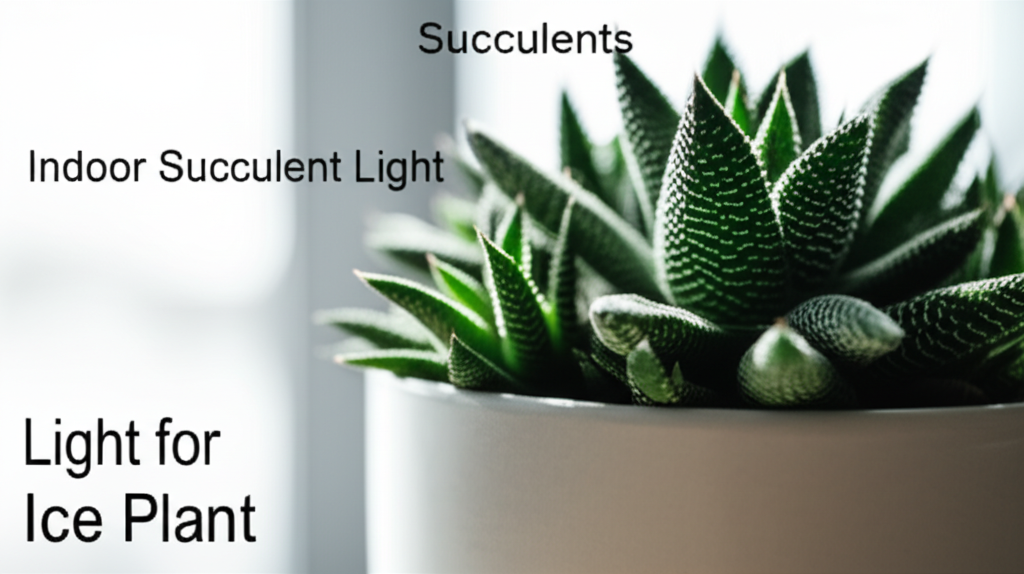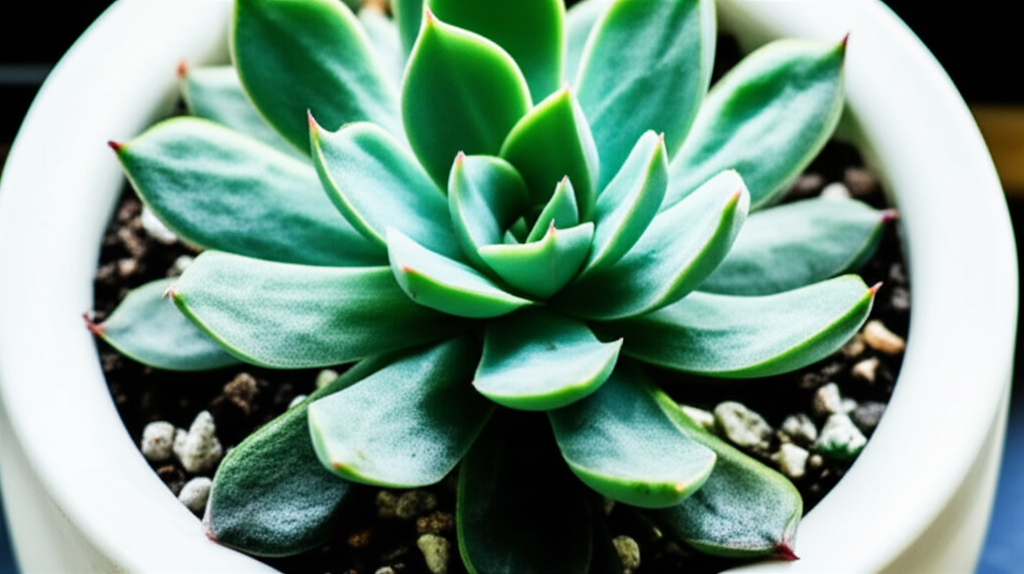Understanding Ice Plant Succulents and Their Light Needs
Ice plants, belonging to the Aizoaceae family, are a diverse group of succulents renowned for their unique, often crystalline epidermal cells that give them a “dewy” or “frosted” appearance. These fascinating plants are native to arid regions of the world, particularly South Africa, where they have evolved to thrive in intense sunlight and arid conditions. This evolutionary background directly dictates their primary requirement for successful indoor cultivation: light.
Why Light is Crucial for Ice Plant Succulents
Succulents, by their very nature, are adapted to store water and energy. This energy production relies heavily on photosynthesis, a process directly fueled by light. For ice plant succulents, insufficient light can lead to a cascade of problems, severely impacting their health and aesthetic appeal.
- Photosynthesis: Light provides the energy necessary for ice plants to convert carbon dioxide and water into sugars, their primary source of nourishment. Without adequate light, this vital process slows down or stops altogether.
- Compact Growth: Sufficient light encourages compact, bushy growth. In low light conditions, ice plants will stretch and become leggy, a phenomenon known as “etiolation.” This results in weak, elongated stems with widely spaced leaves, diminishing their characteristic plumpness and overall visual appeal.
- Color and Texture: The vibrant colors and unique textures that make ice plants so desirable are often intensified by good lighting. Stress from insufficient light can cause them to lose their rich hues and develop a duller appearance.
- Flowering: Many ice plant varieties are prized for their beautiful, often daisy-like flowers. Adequate light is a prerequisite for successful blooming. Plants deprived of light will rarely, if ever, produce flowers.
- Disease Prevention: Well-lit plants are generally healthier and more resistant to pests and diseases. Overwatering, often a consequence of poor light leading to slow growth and water retention, can create an environment conducive to rot and fungal infections.
Assessing Your Indoor Lighting Environment

Before diving into specific lighting solutions, it’s essential to honestly assess the natural light available in your home. Not all windows are created equal, and understanding the nuances of your indoor environment will help you make informed decisions.
Types of Indoor Light Exposure
- Direct Sunlight: This refers to hours of unfiltered, intense sunlight, typically from south-facing windows in the Northern Hemisphere or north-facing windows in the Southern Hemisphere. While many succulents enjoy direct sun, prolonged periods of very hot, direct sun can scorch some delicate ice plant varieties, especially those not acclimated.
- Bright Indirect Light: This is the sweet spot for many indoor plants, including most ice plants. It involves bright light that has been diffused, either by sheer curtains, a translucent window covering, or the angle of the sun throughout the day. East-facing windows often provide excellent morning sun, which is gentler, while west-facing windows offer strong afternoon sun that can be intense.
- Medium Light: This is a less intense but still significant amount of light, typically found in rooms with windows that are partially obstructed or receive light for only part of the day.
- Low Light: This is characterized by minimal natural light, often in rooms with north-facing windows (in the Northern Hemisphere) or in the interior of rooms, far from any windows. Most succulents, including ice plants, will not thrive in low light conditions.
Key Factors to Consider in Your Home
- Window Orientation: As mentioned, the direction your windows face is paramount. South-facing windows (Northern Hemisphere) offer the most consistent and intense light throughout the day. East-facing windows provide gentle morning light, while west-facing windows offer stronger afternoon light. North-facing windows typically provide the least amount of direct light.
- Obstructions: Consider any obstructions outside your windows, such as trees, buildings, or awnings. These can significantly reduce the amount of natural light reaching your plants.
- Time of Year: The intensity and duration of sunlight change seasonally. In winter, days are shorter, and the sun’s angle is lower, meaning even south-facing windows may provide less intense light than in summer.
- Indoor Reflectivity: The color of your walls and decor can influence how much light is reflected and available to your plants. Lighter colors will reflect more light than darker ones.
Optimal Lighting Conditions for Ice Plant Succulents
While generalizations can be made, the “best” light for an ice plant succulent depends on the specific species and its origin. However, a general guideline can be established.
Ideal Light Intensity and Duration
Most ice plant succulents thrive in conditions that mimic their native arid environments, which are characterized by abundant sunlight.
- Minimum Requirement: Aim for at least 6 hours of bright light per day. This can be a combination of direct and indirect light.
- Preferred Condition: Many varieties will flourish with 4-6 hours of direct sunlight, particularly if it’s morning sun, or bright, indirect light for the majority of the day.
- Signs of Too Little Light: Etiolation (stretching), pale or faded colors, loss of plumpness, failure to bloom.
- Signs of Too Much Light (Scorching): Brown or black scorched patches on leaves, wilting despite adequate watering, leaves appearing bleached.
Comparing Light Needs Across Ice Plant Varieties
The Aizoaceae family is vast, encompassing plants with varying tolerances. While many share similar needs, understanding potential differences can prevent disappointment.
| Succulent Type | Ideal Light Conditions | Tolerance to Direct Sun | Notes |
|---|---|---|---|
| Lithops (Living Stones) | Full Sun to Bright Indirect Light | High (morning sun preferred) | Very sensitive to overwatering, needs excellent drainage. |
| Conophytum | Bright Indirect Light | Low to Moderate (morning sun only) | Small, clumping succulents; can scorch easily. |
| Delosperma (Hardy Ice Plant) | Full Sun | High | More tolerant of varied conditions but blooms best in full sun. |
| Mesembryanthemum (Common Ice Plant) | Full Sun | High | Often grown as annuals; can spread and flower profusely. |
| Carpobrotus (Hottentot Fig) | Full Sun | High | Creeping succulent, good for ground cover; tolerates coastal conditions. |
Supplementing Natural Light with Grow Lights
For those whose homes lack sufficient natural light, artificial grow lights are an indispensable tool for cultivating healthy ice plant succulents. Modern LED grow lights offer a spectrum of light specifically tailored to plant growth.
Types of Grow Lights for Succulents
- LED Grow Lights: These are the most popular and energy-efficient option. They come in various forms, including bulbs, panels, and strips, and can be purchased with full-spectrum output, mimicking natural sunlight. Full-spectrum LEDs are ideal as they provide the necessary red and blue wavelengths for robust growth, along with other colors beneficial for overall plant health.
- Fluorescent Grow Lights (T5/T8): While less efficient than LEDs, fluorescent lights can also be effective, particularly T5 high-output bulbs. They are often more affordable upfront but consume more energy and have a shorter lifespan.
- HID (High-Intensity Discharge) Lights: These include Metal Halide (MH) and High-Pressure Sodium (HPS) lights. While very powerful, they generate significant heat and are generally overkill for most home succulent collections, being more suited to commercial or large-scale operations.
Optimizing Grow Light Placement and Duration
The effectiveness of grow lights depends on proper usage.
- Spectrum: Choose full-spectrum lights that include blue and red wavelengths.
- Intensity: The closer the light, the more intense the output. However, be mindful of heat, especially with non-LED lights.
- Distance: For most LED grow lights, a distance of 6-12 inches from the top of the plant is a good starting point. Adjust based on the plant’s response and the specific light’s wattage.
- Duration: Aim for 10-14 hours of artificial light per day to supplement natural light or to provide the sole source of illumination. Use a timer for consistency.
- Avoid Overlap: If using multiple lights, ensure even coverage without excessive overlap that could lead to “hot spots” of intense light.
Troubleshooting Common Lighting Issues
Even with the best intentions, problems can arise. Recognizing the signs and knowing how to correct them is key to successful cultivation.
Identifying and Rectifying Problems
| Symptom | Likely Cause | Solution |
|---|---|---|
| Leggy, stretched growth (Etiolation) | Insufficient light | Move plant to a brighter location, supplement with grow lights. |
| Pale, washed-out color | Insufficient light or overwatering | Increase light exposure. Check soil moisture; allow soil to dry out completely between waterings. |
| Brown or black spots on leaves | Sunburn/scorching (too much direct, intense light) | Move plant out of direct sun, especially during the hottest part of the day. Use a sheer curtain to diffuse intense light. |
| Wilting despite moist soil | Root rot due to poor drainage and/or insufficient light | Check roots for rot. Repot in well-draining soil. Reduce watering frequency and ensure adequate light. |
| No flowering | Insufficient light, improper dormancy period (for some species), or immaturity | Ensure at least 6 hours of bright light daily. Research specific variety needs for dormancy. |
The Role of Dormancy and Light
Some succulent species, including certain ice plants, benefit from a period of reduced watering and light during their natural dormancy. This often occurs in cooler, darker months. While light is still important, a slight reduction might be tolerated or even beneficial for some varieties to trigger flowering in the subsequent growing season. Research the specific needs of your ice plant succulent to understand if a dormancy period is recommended.
Best Practices for Positioning Your Ice Plant Succulents Indoors
Strategic placement is as important as the type of light itself.
Maximizing Natural Light
- South-Facing Windows: The prime real estate for most succulents, offering the most consistent and intense light.
- East-Facing Windows: Excellent for providing gentler morning sun, which is less likely to cause scorching.
- West-Facing Windows: Good for strong light, but be prepared to diffuse intense afternoon sun with sheer curtains, especially in summer.
- Avoid North-Facing Windows: Unless supplemented with strong grow lights, these are generally insufficient for most ice plants.
- Rotate Your Plants: Turn your pots every week or so to ensure all sides of the plant receive adequate light, promoting even growth.
Using Grow Lights Effectively
- Placement: Position grow lights directly above or to the side of your plants, ensuring even coverage.
- Timers: Invest in a simple timer to automate the lighting schedule, ensuring consistency.
- Observation: Regularly check your plants for signs of stress (scorching, stretching) and adjust light intensity or distance accordingly.
Conclusion: A Bright Future for Your Ice Plant Succulents
Providing your ice plant succulents with the right lighting is fundamental to their health, vitality, and beauty. By understanding their natural habitat, assessing your indoor environment, and utilizing a combination of natural and artificial light sources effectively, you can ensure your fascinating, crystalline treasures thrive. Remember that observation is key; your plants will communicate their needs through their appearance. With a little attention to light, your ice plant succulents will reward you with compact growth, vibrant colors, and perhaps even a delightful display of flowers.


